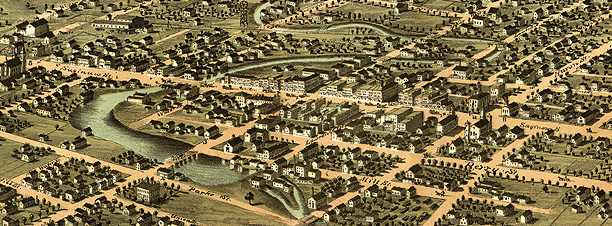






Oakland County and the Anti-Slavery Movement
One center of anti-slavery activity in Oakland County was its county seat, Pontiac, where abolitionists and anti-abolitionists clashed in churches and on the courthouse steps.
For example, In 1839, an antislavery convention was unable to meet in the Presbyterian Church at Pontiac as planned. Before they could even begin their meeting, they confronted a throng of adversaries who told them they were trespassing. Their foes threatened a mob attack if they did not disperse. The attendees met outside and resolved to move their gathering to the following evening in Rochester, a nearby town.
In another incident, in February 1837, antislavery lecturer and Oberlin professor John
P. Cowles encountered a mob as he spoke in a local church in Pontiac.
Taking on a spokesman role, Samuel N. Gantt, the editor of the Democratic Pontiac Balance, told Cowles that he would not be permitted to speak on abolition in this space, and that he would have to leave town. Cowles ignored him, and asked the audience for permission to continue, whereupon most asked him to do so.
Gantt then drew his knife, while his comrades outside of the church began to hurl “a volley of stones and snow balls” into the church windows. For a few tense moments, this attack appeared likely to result in a battle between the friends and foes of abolition in the church.
The parties approached each other and drew weapons and fists, but before blood was shed, the sheriff entered with a posse and calmed the situation. Cowles delivered his lecture “in quiet.” Other Michigan newspapers, apart from Gantt’s own, denounced this attack on free discourse and restriction on speaking.
And again, in February of 1856, following a peaceful meeting in the Pontiac Courthouse, Garrisonian lecturers Richard Glazier of Ann Arbor and Aaron M. Powell of New York encountered a hostile mob when they attempted to speak a second time. While Powell and Glazier obtained the courthouse for their first lecture, the local officials locked them out the following day, fearing “free discussion.” They moved their meeting to another local facility, the “National Hall.” While they “filled” the hall, the relocation did not grant them universal local acclaim. While Glazier spoke, loud voices proclaimed their disapprobation of his message, and a group of youths flung beans and corn at them, which Glazier referred to as being “treated to a rather crude dish of succotash.”
In Pontiac’s hostile community, even the people who provided space to abolitionists could become the targets of attack. Glazier’s lecture the following day proceeded under threat of violence to Mr. Drake, the hall’s owner. Someone anonymously wrote Drake a note indicating that if he permitted the abolitionists to use his hall again, he would risk both “the property” and “his head.” Even so, the meeting proceeded without disturbance.
As a most interesting safeguard, a phalanx of “very kind and firm lady friends” accompanied Glazier and Powell home. Their presence, in Glazier’s view, afforded the men “protection from insult, perhaps injury” from town residents who resented their efforts to impact local culture.
(source: Northwestern University, “Racial Radicals: Antislavery Activism in the Old Northwest, 1830-1861, A Dissertation”, Dana Elizabeth Weiner, Evanston, Illinois, December 2007)



